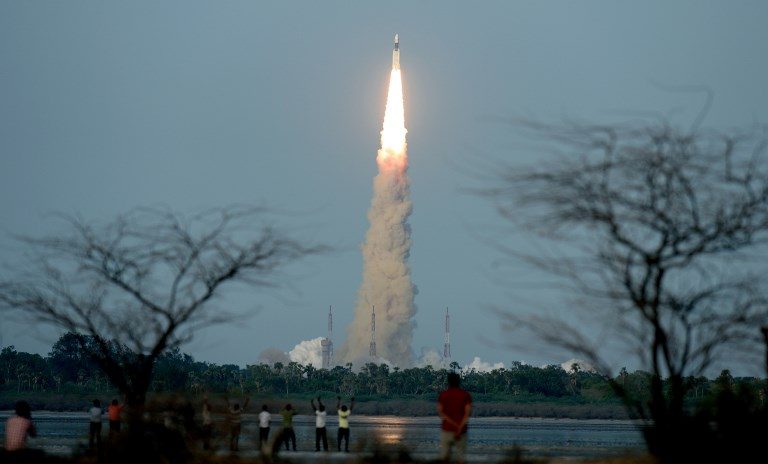SUMMARY
This is AI generated summarization, which may have errors. For context, always refer to the full article.

NEW DELHI, India – India Monday, June 5, successfully launched its most powerful home-produced rocket, another milestone for its indigenous space program which one day hopes to put a human into orbit.
The 43-meter (140-foot) rocket hurtled into a clear sky at 5:28 pm (1158 GMT) from the southern island of Sriharikota, one of two sites used by the Indian Space Research Organisation (ISRO) to launch satellites.
Scientists hugged each other and cheered as the 640-ton rocket lifted off.
“The GSLV – MKIII D1/GSAT-19 mission takes India closer to the next generation launch vehicle and satellite capability,” Prime Minister Narendra Modi posted on his Twitter account.
“The nation is proud!”
The rocket boasts a powerful engine that has been developed in India over many years. Program managers hope to reduce reliance on European engines that have propelled some of India’s spacecraft in the past.
The GSLV Mk III rocket carried a satellite weighing more than 3 tons into a high orbit above Earth, a landmark achievement as India had struggled to match the heavier payloads of other space giants.
“They just launched the most powerful engine in India. It is a cryogenic engine, which took them 20 years to develop. Some engineers have spent their life working on this,” Mathieu Weiss, a representative in India for France’s space agency CNES, told Agence France-Presse.
The launch is another feather in the cap for scientists at ISRO, who won Asia’s race to Mars in 2014 when an Indian spacecraft reached the Red Planet on a shoestring budget.
That feat burnished India’s reputation as a reliable low-cost option for space exploration, with its $73 million price tag drastically undercutting NASA’s Maven Mars $671-million mission.
ISRO is also mulling the idea of missions to Jupiter and Venus.
Reaching for the stars
India is vying for a larger slice of the booming commercial satellite business as phone, internet and other companies seek expanded and more high-end communications.
In February India put a record 104 satellites in orbit from a single rocket, surpassing Russia which launched 39 satellites in one mission in June 2014.
The rocket’s main cargo on that occasion was a 714-kilogram (1,574-pound) satellite for Earth observation but it was also loaded with 103 smaller “nano satellites”, nearly all from other countries.
Although India has successfully launched lighter satellites in recent years, this latest rocket is capable of carrying a massive 4-ton payload into high orbit – twice the capacity of its predecessor, ISRO says.
The space agency tested a less-developed version of the rocket in December 2014 while the cryogenic engine was still in the testing phase.
It carried an unmanned crew capsule which separated from the rocket and splashed down in the Bay of Bengal off India’s east coast 20 minutes after liftoff.
The Indian-made capsule was designed to carry up to 3 astronauts but ISRO said it would take at least another 7 years to reach the point where a crew could be put into space.
India wants to become the fourth nation – after Russia, the United States and China – to put astronauts into orbit but its manned spaceflight program has experienced multiple stops and starts. – Rappler.com
Add a comment
How does this make you feel?
There are no comments yet. Add your comment to start the conversation.